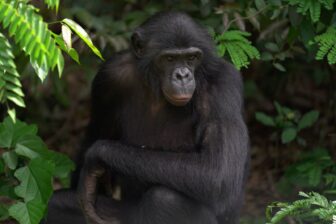Why it’s hard to know
The heart-wrenching images are all too familiar: Dead adult bonobos and starving babies, victims of poachers with a ruthless appetite for bush meat. It seems self-evident that hunting, human encroachment, and other dangers are depleting the numbers of the rarest of African great apes.
Indeed, bonobos are classified as “endangered” on the International Union for Conservation of Nature (IUCN) Red List of Threatened Species — considered to face a high risk of extinction in the not-too-distant future.
But how many bonobos – exactly – are left in the wild? How fast are their numbers declining? The answers are surprisingly unsatisfying.

Bonobos playing in a nest at Ekolo ya Bonobo Community Reserve in 2015.
More Than Wild Guesses?

Bonobos at Ekolo ya Bonobo Reserve in 2018.
In the popular press, estimates of the remaining bonobo population usually fall within the range of 10,000 to 50,000 individual animals. But the IUCN’s 2016 assessment of bonobos pointed out some of the limitations of those estimates.
A systematic analysis found that all the available bonobo survey data collected between 2003 and 2010 covered less than 30% of the bonobos’ geographic range (roughly 565,000 square kilometers in the Democratic Republic of Congo).
From the data that were collected, the researchers, led by the Max Planck Institute for Evolutionary Anthropology, estimated a minimum of 10,000 to 20,000 bonobos still survived in the wild, just within the area studied. But it was impossible to know the number of bonobos remaining in the unsurveyed areas, the IUCN concluded.
It’s not hard to understand why counts of bonobos left in the wild haven’t been more extensive and accurate. After all, developed nations around the world struggle to enumerate their human residents. Estimating animal populations, whether they’re moose in Canada or Tasmanian kangaroos, requires a lot more ingenuity. And the African great apes present some of the biggest challenges of all.
First, You Have to Find Some
The political unrest and wars that have bedeviled the Congo in recent decades have only increased the difficulty of counting the country’s remarkable primate inhabitants. Nonetheless, over the years researchers have developed a number of methods for estimating great ape population numbers.
These include:
- Habituation. In this approach, researchers establish a long-term presence among an animal community, as Jane Goodall did with chimpanzees and Dian Fossey with gorillas. Members of a habituated animal community can be counted with great precision, and the size of their territory can be measured, yielding an accurate picture of the population density. The Wamba research station, established by Japanese researchers in the early 1970s to study bonobos, is an example of this approach. But habituation is far too time-consuming and labor-intensive to be applied throughout the bonobos’ range.
- Nest surveys. All great apes, once they’re weaned, construct sleeping platforms (also known as nests or beds.) This is not instinctive; mothers teach their offspring how to do it. Sometimes built on the ground but more commonly situated in trees as high as 40 feet off the ground, the simple structures are often used for only one night; a separate nest also may be built as a rest spot during the day. Trained observers can spot such nests and count them. Applying statistical tools to the data collected provides a way of estimating how many nest-builders are in a given area.

Cintia Garai conducts bonobo research at Wamba
Counting Nests, Not Apes
Over the past 40 years, nest counts have become the gold standard for monitoring the presence or absence of apes, as well as their abundance, and density. The nests may be counted in different ways. One involves designing a set of transect lines throughout the area of interest. Researchers then walk along the lines, counting all the nests within a fixed width of the line. From the number of nests counted, analysts can extrapolate the population size over the larger area by using various statistical formulas.
While nest surveys have been the primary tool for counting bonobos and other great apes, they have many shortcomings. Transect-line placement theoretically must be random, but this imperative is fraught with problems. If the lines follow roads, trails, ridge lines, or water courses, their placement will almost certainly not be random. Researchers often clear vegetation along the lines, but that activity can affect the animals’ behavior (and make it easier for poachers to follow in the surveyors’ wake!) If the clearing activities are minimized, observers may fail to spot nests directly overhead. The task becomes harder when spotters, working along lengthy transects, are tired, distracted, and/or inexperienced.
How New is That Nest?
Extrapolating animal population size from nest counts also depends on assumptions about how long the nests survive before breaking down. Although nest-decay times have been studied, various researchers have often applied them uniformly to different sites and/or time periods, even though both nest-building techniques and decomposition patterns vary with climate conditions.

Bonobo nest at Ekolo ya Bonobo Community Reserve. The first photo shows the nest and its height. Photo 2 shows the nest close-up.
A study published in 2021 provided insight into the complex interaction of some of these factors. Between 2003 and 2018, the researchers collected data about the weather in the LuiKotale research site west of Salonga National Park in DR Congo. They also surveyed bonobo nest construction and decay in the study area during two periods nine years apart (August 2003- July 2007 and then again July 2016- June 2018). They found a steady decline in rainfall across the 15-year study period, along with evidence that the LuiKotale bonobos built different types of nests in response to the weather conditions at the time.
For example they concocted flimsier but more comfortable nests during dry periods of the year. Overall, nests built in the latter period took 17 days longer to decay than nests built in 2003-2007, when the average monthly rainfall was higher. The study authors predicted that as climate change continues, nest decomposition times are likely to further increase. This could lead people to falsely conclude that ape numbers were increasing, when in fact they were stable or even falling.
New Methods: DNA Sampling

Happily, alternatives to the nest surveys are emerging. One is “genetic tagging.” This approach has the potential for allowing individual animals to be identified with great precision, while avoiding any contact with humans. In the early 1990s, primatologists began reporting on efforts to collect feces, shed and plucked hairs, and other material from bonobos, chimpanzees, and gorillas, then extracting DNA from it.
Such genetic sampling can be exploited to study many questions, but it also has disadvantages. Finding and collecting fecal samples from great apes in the wild requires significant effort, and the equipment and expertise needed to analyze the samples is expensive. Acquiring enough material to estimate population sizes can take years.

Hidden Camera at Ekolo ya Bonobo Community Reserve
Camera Trapping
Cameras triggered by passive infrared motion detectors are another promising new tool for assessing primate populations and monitoring the animals’ behavior. For more than 10 years, so-called camera-trapping techniques have been applied to great apes, with individual animals sometimes distinguished by their facial features and other identifying details. In 2014 the International Journal of Primatology published a special edition devoted to this approach.
Although identifying individual animals from vast pools of photographs can be an overwhelming challenge, systems for automating this work are under development. So are approaches to estimating population sizes by applying new statistical models to camera-trap images that are not individually recognizable. The camera systems also are evolving to reduce the number of “false negatives” (when the cameras fail to capture animals that pass in front of them) as well as false positives (ones triggered by changing light, wind-tossed vegetation, etc.)
As these tools improve, the result should be a sharper and more accurate picture of how many bonobos still inhabit the earth. If that picture creates more attention and concern from their human cousins, we can dream of achieving the IUCN’s vision for 2050: bonobos living in stable and increasing populations across their range and facing minimal threats, their long-term survival ensured.
Sources:
- Fruth B, Hickey JR, André C, Furuichi T, Hart J, Hart T, Kuehl H, Maisels F, Nackoney J, Reinartz G, Sop T, Thompson J, Williamson EA (2016) [errata version of 2016 assessment]. “Pan paniscus”. IUCN Red List of Threatened Species. 2016: e.T15932A102331567. https://www.iucnredlist.org/species/15932/102331567
- Kühl HS, Maisels F, Ancrenaz M et al. Best practice guidelines for the surveys and monitoring of great ape populations. IUCN SSC Primate Specialist Group (PSG). 2008; Gland, Switzerland. https://portals.iucn.org/library/efiles/documents/ssc-op-036.pdf
- Bessone M, Booto L, Santos A, et al. No time to rest: how the effects of climate change on nest decay threaten the conservation of apes in the world. Plos ONE 16(6): e0252527. https://journals.plos.org/plosone/article?id=10.1371/journal.pone.0252527
- Howe EJ. (2019). Estimating abundance of African great apes. [Doctoral thesis, University of St. Andrews]. http://hdl.handle.net/10023/18859
- Pebsworth PA, LaFleur M. 2014. Advancing primate research and conservation through the use of camera traps: introduction to the special issue. Int J Primatol 35, 825–840 (2014). https://doi.org/10.1007/s10764-014-9802-4
- Santini G, Abollaffio M, Ossi F et al. Population assessment without individual identification using camer-traps: a comparison of four methods. https://www.sciencedirect.com/science/article/pii/S1439179122000263
Jeannette De Wyze was a journalist at the San Diego Reader for 30 years. Today she’s a bonobo lover and supporter and the volunteer liaison between Women’s Empowerment International and the Nyaka Grannies Project in Uganda. She also raises puppies to be service dogs for Canine Companions for Independence and is an active blogger.

 Kendra is a creative problem-solver who provides executive and operational support across the organization. As Executive Assistant to Ariel Rogers, she manages scheduling, communications, and day-to-day priorities while also supporting the development and communications teams with administrative and operational needs.
Kendra is a creative problem-solver who provides executive and operational support across the organization. As Executive Assistant to Ariel Rogers, she manages scheduling, communications, and day-to-day priorities while also supporting the development and communications teams with administrative and operational needs. Kathleen Cook brings more than nine years of experience working across Africa, with a focus on the Democratic Republic of Congo, where she has traveled over twenty times to support projects spanning conservation, clean energy, and community development. Her career has centered around using storytelling, strategic marketing, and relationship-building to create meaningful impact.
Kathleen Cook brings more than nine years of experience working across Africa, with a focus on the Democratic Republic of Congo, where she has traveled over twenty times to support projects spanning conservation, clean energy, and community development. Her career has centered around using storytelling, strategic marketing, and relationship-building to create meaningful impact.
